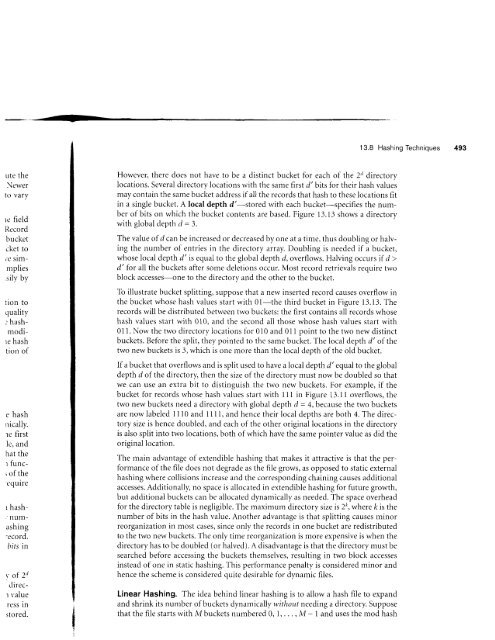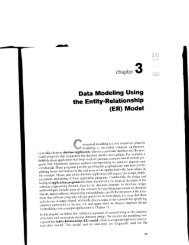13.1 through 13.5, 13.10 and 13.11
13.1 through 13.5, 13.10 and 13.11
13.1 through 13.5, 13.10 and 13.11
Create successful ePaper yourself
Turn your PDF publications into a flip-book with our unique Google optimized e-Paper software.
'l 3.8 Hashing Techniquesute theNewert() varyre fieldI{ccordbucketcket toie slmrnplies.sily bytlon toquality-. hashn-rodirehashtion ofe hashnically.re firstle, <strong>and</strong>hat ther func-; of thecquirer hash-.'numashing:ecord.&irs invof2ddirecrvalueress instored.However, there does not have to be a distinct bucket for each of the 2,i directorylocations. Several directory locations rvith the same first d'bits tbr their hash valuesmay contain the same bucket address if all the records that hash to these locations fitin a single bucket. A local depth d'-stored with each bucket-specifies the numberof bits on lvhich the bucket contents irre based. Figure <strong>13.1</strong>3 shows a directorywith global depth ri = 3.The value of d can be increased or c-lecreased by one at a time, thus doublir-rg or halvingthe number of entries ir-r the directory array. Doubling is needed if a bucket,whose local depth d' is equal to the global depth d, overflows. Halving occurs if d >d'for all the buckets after some deletions occur. Most record retrievals require twoblock accesses-one to the directory <strong>and</strong> the other to the bucket.To illustrate br.rcket splitting, suppose thirt a new inserted record causes overflow inthe bucket whose hash values start with 0l-the third bucket in Figure <strong>13.1</strong>3. Therecords will be distributed between twcl bnckets: the first contains all records whosehash values start with 010, ar-rd the second all those rvhose htrsl-r values start witl-r011. Norv the two directory locations fbr 0t0 <strong>and</strong> 0l I point to the two new distinctbuckets. Before the split, they pointed to the sante bucket. The local depth d' of thetwo new buckets is 3, which is one more than the local depth of the old bucket.If a bucket that overflows <strong>and</strong> is split used to have a locai depth d' equal to the globaldepth d of the directory, then the size of the directory must now be doubled so thatwe can use au extra bit to distinguish the two new buckets. For example, if thebucket for records rvhose hash values start with lll in Figure 1-3.11 overflows, thetwo new buckets need a directory with global depth d = 4, because the two bucketsare now labeled I I l0 <strong>and</strong> 1111, <strong>and</strong> hence their local depths are both 4. The directorysize is l-rence doubled, <strong>and</strong> each of the other original locations in the directoryis also split into two locations, both of which have the same pointer value as did theoriginal location.The rnain advantage of extendible hashing that makes it attractive is that the performanceof the file does not degrade as the file grows, as opposed to static externalhashing where collisions increase <strong>and</strong> the corresponding chaining caLlses additionalaccesses. Additionally, no space is allocated in extendible hashing tbr fttture growth,but additional buckets can be allocated dynamically as needecl. The space overheadfor the directory tabie is negligible. The maximum directory size is 2t, where k is thenumber of bits in the hash value. Another advantage is that splitting causes minorreorganization in most cases, since only the records in one bucket are redistributedto the two new buckets. The only time reorganization is more expensive is when thedirectory has to be doubled (or halved). A disadvantagethat the directory must besearched before accessing the buckets themselves, resulting in two block accessesinstead of one in static hashing. This perfbrmance penalty is considered minor <strong>and</strong>hence the scheme is considered quite desirable tbr dynamic files.Linear Hashing. The idea behind linear hashing is to ailow a hash file to exp<strong>and</strong><strong>and</strong> shrink its number of buckets dynar-r,ically without needing a directory. Supposethat the file starts withMbuckets numbered0, 1,... ,M- l <strong>and</strong> uses the modhash














